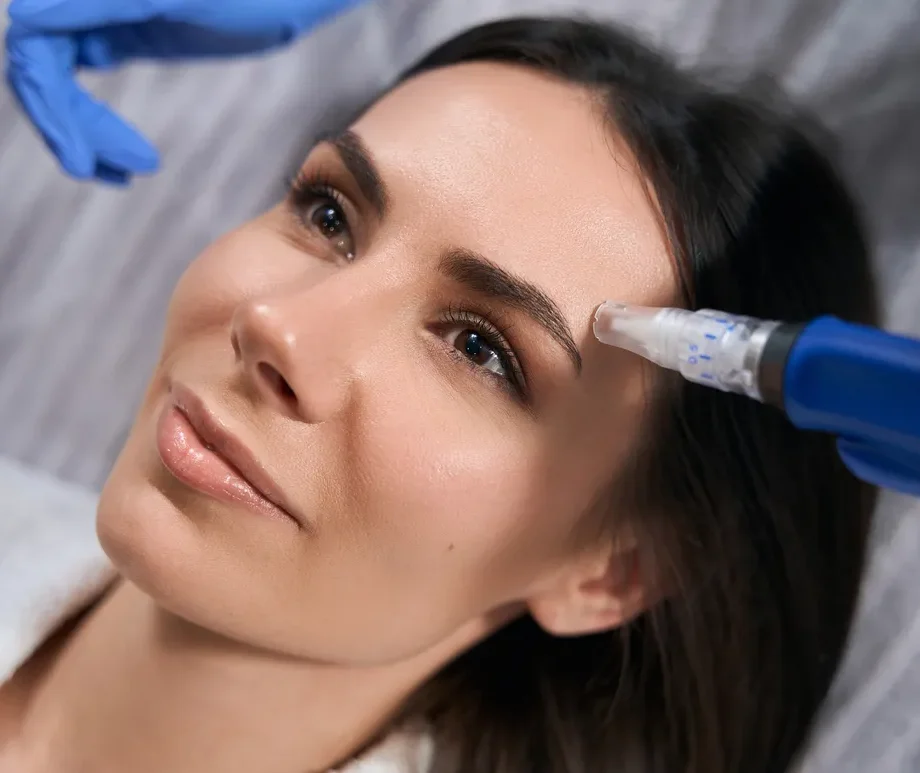At CHS Med Spa Medical Spa, our experienced team of skincare professionals is dedicated to helping you achieve beautiful, healthy-looking skin.

Transform Your Skin at CHS Med Spa Medical Spa
Microneedling is an aesthetic treatment that uses a device with fine needles to prick the skin to stimulate extra collagen production, which can help heal scars and reduce signs of aging.
Microneedling with platelet rich plasma (PRP) uses centerfuge-seperated plasma from a small blood sample from patient.
What is microneedling with PRP?
Microneedling with PRP is an aesthetic treatment that stimulates collagen production by rolling very fine needles over the skin and applying platelets from the patient, which are one of the components of blood.
The addition of PRP from the blood may make microneedling more effective. The liquid in blood is plasma, while platelets are solid. Platelets help blood clot, so they are vital for healing wounds and injuries. PRP is plasma in which the concentration of platelets is higher than that of other components of the blood.
FIrst we will take a blood sample and then use a centrifuge to separate the PRP from the remainder of the blood.
PRP contains proteins, including growth factors and cytokines. These proteins can help skin tissue repair itself.
Next, our experienced technician will use a microneedling tool to make tiny holes in the skin’s surface. We will then apply the prepared PRP to the recently “damaged” skin to encourage collagen production and cell reproduction.
What are the side effects?
Recovery from microneedling is usually quick. Patients sometimes experience soreness and tenderness immediately after the treatment. The area may also have redness, and there may be some mild bruising, which usually clears within 4–5 days.
Other side effects can happen while the skin heals, including:
Taking acetaminophen can help relieve any discomfort or painful side effects.
Who should not have this procedure?
Microneedling with PRP may not be suitable during pregnancy or for people with certain conditions or other risk factors, including those who have:
If people fall into any of these categories, they should consult with their doctor about the safety of microneedling with PRP treatment.
What is Microneedling with PRP used to treat?
The addition of PRP to microneedling may speed up the healing process and stimulate skin renewal, potentially producing better results than microneedling alone. This popular procedure can be used to treat:
Notable studies:
Platelet-rich plasma and its utility in the treatment of acne scars: A systematic review
microneedling, prp, rf microneedling, botox, skinpen, medical spa, treatments, treatment
microneedling decatur, chs med spa
Microneedling with PRP (platelet-rich plasma) is an innovative aesthetic treatment that combines the benefits of microneedling with the healing properties of PRP. This procedure involves using a specialized device to create micro-injuries in the skin, which stimulates collagen production and enhances skin rejuvenation. The addition of PRP, derived from the patient's own blood, enhances healing and promotes healthier skin.
This treatment is particularly effective for addressing various skin concerns, including acne scars, wrinkles, and uneven skin tone. By harnessing the body's natural healing processes, microneedling with PRP offers a safe and minimally invasive solution for those looking to improve their skin's appearance and texture.
The benefits of microneedling with PRP extend beyond just skin rejuvenation. This procedure can significantly improve skin texture, reduce the appearance of fine lines and wrinkles, and enhance overall skin tone. Additionally, PRP contains growth factors that promote healing and regeneration, leading to more effective results compared to traditional microneedling alone.
Patients often report a noticeable improvement in skin elasticity and firmness after treatment. Furthermore, the procedure requires minimal downtime, making it an appealing option for those with busy lifestyles who still want to achieve radiant skin without extensive recovery periods.
While microneedling with PRP is generally considered safe, potential side effects may include temporary redness, swelling, and mild bruising at the treatment site. These effects typically resolve within a few days. It's crucial for patients to consult with a qualified professional to determine if they are suitable candidates for the procedure, especially those with specific skin conditions or health concerns.
Individuals who have active skin infections, are pregnant, or have certain blood disorders should avoid this treatment. A thorough consultation will help assess any risks and ensure the treatment aligns with the patient’s health profile, optimizing safety and effectiveness.
Microneedling with PRP is ideal for individuals seeking to improve their skin's appearance and address specific concerns such as acne scars, fine lines, and sun damage. This treatment is suitable for a wide range of skin types and can benefit both men and women looking for a non-surgical option to achieve youthful, vibrant skin.
Those interested in this procedure should have realistic expectations about the outcomes and be prepared for a series of treatments to achieve optimal results. Consulting with a skincare professional can help determine the best treatment plan tailored to individual skin needs and goals.